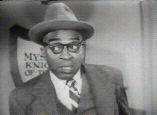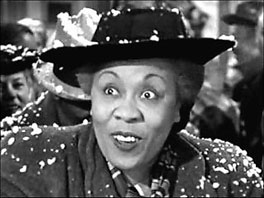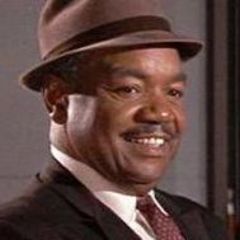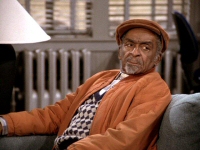“We are all brothers. . . .”
May 4, 2012
I gather from schnibles I’ve seen on the Internet that 30 Rock caught some flack for a parody of the 1950s television series Amos ‘n’ Andy. In the 30 Rock sketch, which was called Alfie and Abner, the characters were played by Tracy Morgan and John Hamm, who was in black face and an Afro wig, an image some folks found offensive. Somewhat incongruously — not to put too fine a point on it — the set was a replica of the Kramdens’ Bensonhurst kitchen rather than the most frequent Harlem scenes on Amos ‘n’ Andy — the Mystic Knights of the Sea lodge hall and the apartment of George and Sapphire Stevens.
The premise of the 30 Rock sketch was that one actor was in black face because NBC thought it would be too big a step to have two black actors on the stage at the same time. The irony is that Amos ‘n’ Andy, which had its original run from 1951 to 1953, was the first television series to have virtually an all black cast. White actors appeared in incidental roles in only a handful of episodes. I think it’s fairly well known that the show was driven out of production because of objections — most prominently from the National Association for the Advancement of Colored People — on the grounds that it presented negative stereotypes of black Americans. It continued in reruns on some stations into the 1960s.
The television series evolved from a radio series that ran from 1928 until 1960. At the height of its success, Amos ‘n’ Andy was not only the most popular radio show on the air but the most popular diversion of any kind. And yet that series featured white actors mimicking black characters — namely Freeman Gosden and Charles Correll, who created the show. For a while, Gosden and Correll performed all the male roles and some of the females. Later, other actors and actresses were cast in the supporting parts while Gosden and Correll continued to play the principal figures: Amos Jones, Andrew H. Brown, and George “Kingfish” Stevens. Gosden and Correll went a step further in the 1930 RKO movie “Check and Double Check,” donning black face to play Amos (Gosden) and Andy (Correll). Duke Ellington and his orchestra appeared in that movie.
The TV series is now controlled by CBS, which has withdrawn it from circulation and has at times taken legal action in an attempt to squelch the widespread Internet sale of bootleg tapes and DVDs of the episodes.
The Amos ‘n’ Andy television show is in a unique position, I think, in the sense that if it were judged in a vacuum — with no reference to who created it and when it first appeared — the conclusion might be different than it is when the show is viewed in its historical context. It was introduced when black American citizens in large numbers were still being denied their civil rights, when black people in many parts of the country were regularly threatened with violence, and when black people were freely lampooned in movies, cartoons, and minstrels. The show was still being broadcast in syndication in 1955, when Sarah Louise Keys, Claudette Colvin, and Rosa Parks in turn refused to give up their seats on the Montgomery, Alabama bus system to make way for white passengers. With Jim Crow making his last stand against legal equality and common decency, it shouldn’t have been surprising that black society and others would object to some of the characterizations on Amos ‘n’ Andy.
I have owned copies of all 78 known episodes of the series for many years, and I have watched them all several times and assigned students to write about them. I have also done a lot of research about the show itself and about the actors who appeared in it, and I have interviewed several people who were connected to it, including Nick Stewart who played Lightnin’ — the janitor at the lodge hall. Based on all that exposure, I think one can at least make the argument that, taken out of its milieu, Amos ‘n’ Andy would be no more offensive than all-black sitcoms that have appeared since, including Sandford and Son and Family Matters.
In fact, Amos ‘n’ Andy is fashioned on the same model as The Honeymooners. The rap on Amos ‘n’ Andy has been that it perpetuates stereotypes of black men as lazy, shiftless, and dumb, and of black women as shrewish and unattractive. As for the men, those characterizations apply to only four characters in the series: Andy Brown (Spencer Williams Jr.), George “Kingfish Stevens (Tim Moore), Lightnin’ (Nick Stewart, billed as Nick O’Deamus), and the lawyer Algonquin J. Calhoun (Johnny Lee).
These men live in a universe in which virtually everyone is black and, significantly, in which everybody but them is dignified, moral, and responsible. Just as The Honeymooners didn’t imply that all white men were naive schemers like Ralph Kramden or good-natured dumbbells like Ed Norton, Amos ‘n’ Andy didn’t imply that all black men were lummoxes, wasters, or charlatans. In both cases, the point was that the main characters were out of step with everyone around them; they were the exceptions, not the rules.
The most prominent female character on Amos ‘n’ Andy was Sapphire Stevens, the Kingfish’s wife. Sapphire was played by Ernestine Wade, who actually was a pretty woman. Sapphire longed for a more genteel life in which she wasn’t hounded by bill collectors and in which she could associate with folks a little more erudite and stimulating than Andy Brown. Wade portrayed her as a decent woman who was faithful to a husband who didn’t deserve it; if Sapphire nagged the Kingfish and at times lost her temper with him, no one could blame her any more than they could blame Alice Kramden from blowing up at Ralph.
Less sympathetic a character, perhaps, was Ramona Smith, Sapphire’s mother, who was presented as the classic bellicose battleship of a mother-in-law — an accessory the Kingfish had in common with Ralph Kramden.
The broadest of the regular characters were the shambling, drawling Lightnin’, and Calhoun, a loudmouth and a fake.
There was a shift in emphasis in the television series in which Amos, although a title character and often the voice that introduced the episode (“Hello, folks. This is Amos. . . .”), became a secondary figure, and the Kingfish became the focal point of almost every episode. In the TV series, Amos was a level-headed, intelligent, soft-spoken, man who owned his own taxicab and led a quiet life with his lovely wife, Ruby, and their two daughters. Amos was often the Jiminy Cricket to the Kingfish and Andy, giving them sound advice and sometimes directly getting them out of trouble.
An aspect of this show that is always overlooked is the quality of the cast it brought together. Many of the actors had long careers as entertainers, persisting through an era in which they were unappreciated, type cast, and often rudely treated.
Tim Moore, who played the chronically unemployed and finagling Kingfish, had a remarkable life as a vaudevillian, entertaining all over the world. He also appeared in several Broadway shows and in films. He was even fairly successful as a boxer. He was lured out of retirement to play the role in Amos ‘n’ Andy. His character’s sobriquet was actually his title as head of the lodge — the kingfish. When he wanted his pals to bail him out of some scrape, he often reminded them, “After all, we are all brothers in that great organization, the Mystic Knights of the Sea.”
Spencer Williams Jr., who played the sweet but gullible oaf Andy Brown, was an important figure in the history of American film. A World War I army veteran who worked in many aspects of the movie business, including as a sound technician, eventually became a writer, director, and producer of so-called “race movies,” films that were made specifically to be shown in segregated theaters. His film “Go Down Jesus,” which was made on a $5,000 budget and with nonprofessional actors, was one of the most successful “race films” of all time. Time magazine called it one of the “25 most important films on race.”
Alvin Childress, who played the sensible and gentle Amos Jones, held a bachelor’s degree in sociology. He began working as an actor with a Harlem theater company, and he worked on both the stage and on film. He appeared on Broadway as Noah in Philip Yordan’s play Anna Lucasta, which ran for 957 performances. Although he appeared in a couple movies and in episodes of Perry Mason, Sandford and Son, Good Times, and The Jeffersons, Childress, who felt he had been typed by casting directors as Amos Jones, had a hard time sustaining his career. His first marriage, which lasted for 23 years, was to a well known writer and actress, Alice (Herndon) Childress.
Nick Stewart, who played Lightnin’, was a dancer and comedian who appeared in night clubs, Broadway shows, films, and radio. Stewart was the voice of Br’er Bear in the 1946 Disney movie Song of the South. In 1950, He and his wife, Edna, founded the Ebony Showcase Theater in Los Angeles, where for many years they provided a venue in which black actors could appear in quality productions.
Johnny Lee, who played the blustering, incompetent lawyer, Algonquin J. Calhoun, was a dancer and actor who appeared in a couple of dozen films and television shows, perhaps most notably as the voice of Br’er Rabbit in Song of the South. He had featured roles in Come On, Cowboy! (1948) and She’s Too Mean for Me (1948) and he played a stuttering bill collector in Boarding House Blues (1948). He also starred in an all-black musical comedy, Sugar Hill, at the Las Palmas Theatre in Hollywood in 1949. His last TV role was Mr. Gibbons the Locksmith on Dennis the Menace in 1963.
In addition to these regular players, Amos ‘n Andy provided occasional roles for some very talented actors, including the sisters Amanda and Lillian Randolph. Amanda Randolph, who played Ramona Smith, mother of Sapphire Stevens, was the first black actress to appear on a regularly-scheduled network television show. That was The Laytons, which appeared on the old Dumont network for two months in 1948. She was an exceptional jazz pianist and a composer. She appeared in New York musicals, entertained in Europe, performed in vaudeville, and cut records as both a musician and a vocalist. She appeared on Broadway, in films, and on radio. On radio, she played the title role in Beulah in the 1953-1954 season, inheriting the role from Lillian.
She was the first black American actress to have her own daytime network TV show — Amanda, which ran on Dumont in the 1948-49 season. Among her many TV roles was Louise, the wisecracking maid on Danny Thomas’s comedy series.
Lillian Randolph, who appeared in Amos ‘n’ Andy as Madame Queen, a former girlfriend of Andy Brown, was also a multi-talented performer on radio, television, and film. She had played Madame Queen on the radio, too, and made the character’s name a household word in the United States. She played the maid Birdie Lee Coggins in The Great Gildersleeve radio series, and she repeated the role in Gildersleeve films and the later TV series. Her performance of a gospel song on the TV series led to a gospel album on Dootone Records. She also made regular appearances on The Baby Snooks Show and The Billie Burke Show on radio. Her best known film roles probably were Annie in It’s a Wonderful Life and Bessie in The Bachelor and the Bobby Soxer. Her television roles included Bill Cosby’s mother on The Bill Cosby Show, and Red Foxx’s aunt Esther on Sandford and Son. Altogether, she appeared in about 93 movie and television properties. In 1954, Lillian Randolph became the first black member of the board of directors of the Hollywood Chapter of the American Federation of Television and Radio Artists.
One of the most eminent persons to appear on the Amos ‘n’ Andy TV series was Jester Hairston, who made occasional appearances as both Sapphire’s brother Leroy and as wealthy and dapper lodge member Henry Van Porter. Although he appeared in about 20 films and several TV shows, acting was secondary to Hairston’s career as a composer, songwriter, arranger, and choral conductor. He wrote the song “Amen” for the 1963 film Lilies of the Field and he dubbed the song for Sidney Poitier to lip-sync. He also wrote the Christmas carol Mary’s Little Boy Child. Harry Belafonte’s recording of the song reached No. 1 on the charts in the UK in 1957. From 1986 to 1991, Hairston played Rolly Forbes in the TV series Amen.
Hairston was a graduate of Tufts University, and he studied music at the Julliard School. He was highly regarded as a conductor of choirs, including on Broadway, and as a composer and arranger of choral music. In 1985, when few foreign performers were appearing in China, he took a multi-racial choir to tour the country. Hairston was a founder of the Screen Actors Guild.
Also among the actors who appeared on Amos ‘n’ Andy was Roy Glenn, who had a rich baritone-bass voice that he got to use in one episode, singing some lines from “Red Sails in the Sunset.” Glenn had a long acting career, appearing in 96 films and television shows. His most prominent role probably was Sidney Poitier’s father in Guess Who’s Coming to Dinner (1967).
The only Amos ‘n’ Andy alumnus I’m aware of who not only is still living but has worked as an actor recently is Jay Brooks, who appeared in two episodes of Seinfeld, as Sid, the man who provides a service in Jerry Seinfeld’s neighborhood by moving cars from one side of the street to the other to comply with New York City’s alternate-side parking regulations.
The actors who appeared on Amos ‘n’ Andy were often criticized for accepting roles on a show that some people felt was demeaning to black people. More often than not, the roles offered to black performers in those days in any venue were stereotyped if they weren’t out-and-out offensive. Some of the actors — Alvin Childress, for example — argued that they had to work where they could and that by accepting parts on the first all-black show on television, they had paved the way for others to follow. It’s too late to resolve that question but, taken on its own merits, Amos ‘n’ Andy was a funny show, due in large part to the performances of a lot of experienced actors who, over their careers, made enormous contributions to American popular culture. They don’t deserve to be forgotten.












